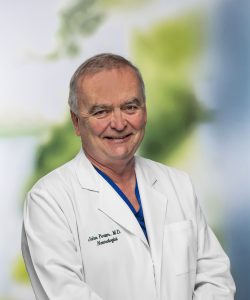Bon Secours recognizes National Stroke Awareness Month in May
May 9, 2022Encourages FAST action following onset of symptoms
About every 40 seconds, someone in America has a stroke – a leading cause of death and disability. So, Bon Secours is observing Stroke Awareness Month to bring attention to the signs and symptoms of stroke, information that can save a life when recognized early.
“Every second counts, because millions of brain cells immediately begin to die when a stroke occurs,” said Dr. John Porter, a neurologist with Bon Secours Neurology. “How soon you’re able to get treatment can mean the difference between a full recovery and permanent disability or even death.”
There are three types of strokes. An ischemic stroke happens when the supply of blood to your brain is blocked. A hemorrhagic stroke occurs when the blood vessels around your brain tissue burst. The last type is called a transient ischemic attack (TIA) which involves a temporary blockage of blood flow to the brain.
“These are sometimes referred to as a ‘mini-stroke’ because the symptoms typically only last a few minutes, but it’s just as important that you seek medical attention right away. Too many people shrug it off thinking, ‘Oh, it went away so I’m fine,’ but the truth is a TIA is a huge red flag that things are not fine. This is your body’s way of warning you to take action before it’s too late,” explained Dr. Porter.
Medical experts say anytime someone experiences stroke symptoms, they need to BE FAST. Not only will remembering that phrase remind you to act quickly, but it can also help you recall the most common symptoms of a stroke:
- Balance – Is the person dizzy? Can they walk?
- Eyes – Can the person see? Is their vision blurry?
- Facial Droop – Can they smile? Is one side of their face sagging?
- Arm Weakness – Are their arms moving normally? Is one arm weaker or numb?
- Speech Difficulty – Is it slurred or strange when asked to say simple phrases?
- Time to Call 911 – Don’t waste time getting help, and do not try to drive yourself.
“Calling 911 is crucial to saving time when every minute counts toward getting a better outcome. It allows EMS to begin initial assessments during the ride to the hospital, and they can also alert our teams so we can prepare to begin testing and treating the patient immediately upon their arrival.”
Bon Secours created a Cerebrovascular and Stroke Advisory Council in 2018 to help improve Upstate stroke care. It brings together medical experts, stroke patients, and community members to discuss ways to increase awareness and stroke education as well as improve patient experiences and outcomes. If you’d like to get involved, you can contact the Neuroscience Program Coordinator, Casey Smith at [email protected] or by calling 864-255-1040.
You can also learn more about the stroke treatment and care offered at Bon Secours by visiting bonsecours.com.
Bon Secours St. Francis Health System is part of Bon Secours Mercy Health, one of the 20 largest health systems in the United States and the fifth-largest Catholic health system in the country. The ministry’s quality, compassionate care is provided by more than 60,000 associates serving communities in Florida, Kentucky, Maryland, New York, Ohio, South Carolina, and Virginia, as well as throughout Ireland. Bon Secours St. Francis Health System provides compassionate medical care to thousands of area residents through Bon Secours St. Francis Downtown and Bon Secours St. Francis Eastside, as well as a network of primary and specialty care practices, and ambulatory care sites across the Greenville region. The mission of Bon Secours St. Francis Health System is to extend the compassionate ministry of Jesus by improving the health and well-being of our communities and bring good help to those in need, especially people who are poor, dying and underserved. For more information, visit BonSecours.com.














